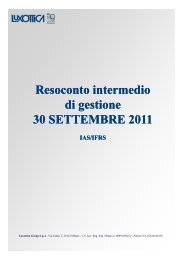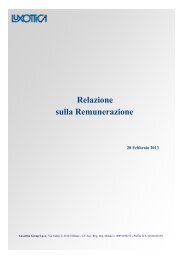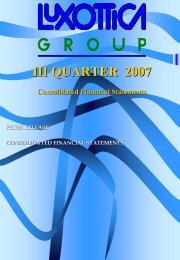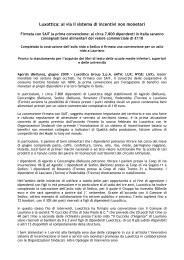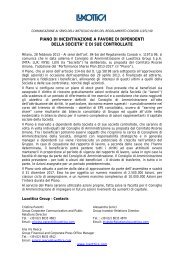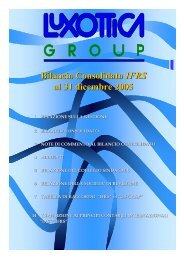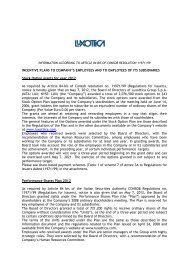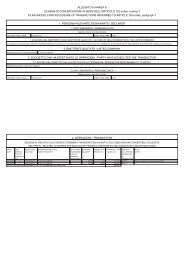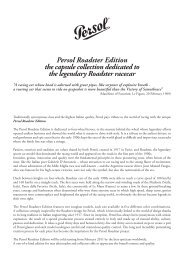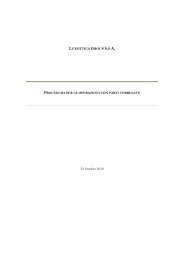ANNUAL REPORT 2004 - Luxottica Group
ANNUAL REPORT 2004 - Luxottica Group
ANNUAL REPORT 2004 - Luxottica Group
Create successful ePaper yourself
Turn your PDF publications into a flip-book with our unique Google optimized e-Paper software.
NOTES TO CONSOLIDATED FINANCIAL STATEMENTS<br />
STORE OPENING AND CLOSING COSTS<br />
Store opening costs are charged to operations as<br />
incurred in accordance with Statement of Position No.<br />
98-5, Accounting for the Cost of Start-up Activities. The<br />
costs associated with closing stores or facilities are<br />
recorded at fair value as such costs are incurred. Store<br />
closing costs charged to the Statements of<br />
Consolidated Income during fiscal years 2002, 2003<br />
and <strong>2004</strong> were not material.<br />
SELF INSURANCE<br />
The Company is self insured for certain losses<br />
relating to workers’ compensation, general liability,<br />
auto liability, and employee medical benefits for<br />
claims filed and for claims incurred but not reported.<br />
The Company’s liability is estimated on an<br />
undiscounted basis using historical claims<br />
experience and industry averages; however, the final<br />
cost of the claims may not be known for over five<br />
years. As of December 31, 2003 and <strong>2004</strong> self<br />
insurance accruals were Euro 18.6 million and Euro<br />
36.1 million, respectively.<br />
INCOME TAXES<br />
Income taxes are recorded in accordance with SFAS<br />
No. 109, Accounting for Income Taxes, which<br />
requires recognition of deferred tax assets and<br />
liabilities for the expected future tax consequences<br />
of events that have been included in the Company’s<br />
consolidated financial statements or tax returns.<br />
Under this method, deferred tax liabilities and assets<br />
are determined based on the difference between the<br />
consolidated financial statement and tax basis of<br />
assets and liabilities using enacted tax rates in effect<br />
for the year in which the differences are expected to<br />
reverse. A valuation allowance is recorded for<br />
deferred tax assets if it is determined that it is more<br />
likely than not that the asset will not be realized.<br />
LIABILITY FOR TERMINATION INDEMNITIES<br />
Termination indemnities represent amounts accrued<br />
for employees in Australia, Austria, Greece, Israel, Italy<br />
and Japan, determined in accordance with labour<br />
104<br />
laws and agreements in each respective country (see<br />
Note 9).<br />
REVENUE RECOGNITION<br />
Revenues include sales of merchandise (both<br />
wholesale and retail), insurance and administrative<br />
fees associated with the Company’s managed vision<br />
care business, eye exams and related professional<br />
services, and sales of merchandise to franchisees<br />
along with other revenues from franchisees such as<br />
royalties based on sales and initial franchise fee<br />
revenues.<br />
Wholesale division revenues are recorded from sales<br />
of products at the time of shipment, as title and the<br />
risks and rewards of ownership of the goods are<br />
assumed by the customer at such time. The products<br />
are not subject to formal customer acceptance<br />
provisions. In some countries, the customer has the<br />
right to return products for a limited period of time<br />
after the sale. However, such right of return does not<br />
impact the timing of revenue recognition as all<br />
conditions of SFAS No. 48, Revenue Recognition<br />
When Right of Return Exists, are satisfied at the date of<br />
sale. Accordingly, the Company has recorded an<br />
accrual for the estimated amounts to be returned.<br />
This estimate is based on the Company’s right of<br />
return policies and practices along with historical data<br />
and sales trends. There are no other post-shipment<br />
obligations.<br />
Retail division revenues, including internet and<br />
catalog sales, are recorded upon receipt by the<br />
customer at the retail location, or when goods are<br />
shipped directly to the customer for internet and<br />
catalog sales. In some countries, the Company<br />
allows retail customers to return goods for a period of<br />
time and as such the Company has recorded an<br />
accrual for the estimated amounts to be returned.<br />
This accrual is based on the historical return rate as a<br />
percentage of net sales and the timing of the returns<br />
from the original transaction date. There are no other<br />
post-shipment obligations. Additionally, the retail<br />
division enters into discount programs and similar<br />
relationships with third parties that have terms of<br />
twelve or more months. Revenues under these<br />
arrangements are likewise recognized as transactions<br />
occur in the Company’s retail locations and



